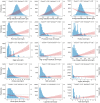Dietary Protein Sources, Mediating Biomarkers, and Incidence of Type 2 Diabetes: Findings From the Women's Health Initiative and the UK Biobank
- PMID: 35713602
- PMCID: PMC9346982
- DOI: 10.2337/dc22-0368
Dietary Protein Sources, Mediating Biomarkers, and Incidence of Type 2 Diabetes: Findings From the Women's Health Initiative and the UK Biobank
Abstract
Objective: Whether and how dietary protein intake is linked to type 2 diabetes (T2D) remains unclear. The aim of this study was to investigate the associations of protein intake with development of T2D and the potential mediating roles of T2D biomarkers.
Research design and methods: We included 108,681 postmenopausal women without T2D at baseline from the Women's Health Initiative (WHI) (primary cohort) and 34,616 adults without T2D from the U.K. Biobank (UKB) (replication cohort). Cox proportional hazard models were used for estimation of protein-T2D associations. Mediation analysis was performed to assess the mediating roles of biomarkers in case-control studies nested in the WHI.
Results: In the WHI, 15,842 incident T2D cases were identified during a median follow-up of 15.8 years. Intake of animal protein was associated with increased T2D risk (hazard ratio in comparing the highest to the lowest quintile = 1.31 [95% CI 1.24-1.37]) and plant protein with decreased risk (0.82 [0.78-0.86]). Intakes of red meat, processed meat, poultry, and eggs were associated with increased T2D risk and whole grains with decreased risk. Findings from the UKB were similar. These findings were materially attenuated after additional adjustment for BMI. Substituting 5% energy from plant protein for animal protein was associated with 21% decreased T2D risk (0.79 [0.74-0.84]), which was mediated by levels of hs-CRP, interleukin-6, leptin, and SHBG.
Conclusions: Findings from these two large prospective cohorts support the notion that substituting plant protein for animal protein may decrease T2D risk mainly by reducing obesity-related inflammation.
© 2022 by the American Diabetes Association.
Figures

References
-
- Hu FB, Manson JE, Stampfer MJ, et al. . Diet, lifestyle, and the risk of type 2 diabetes mellitus in women. N Engl J Med 2001;345:790–797 - PubMed
-
- Khazrai YM, Defeudis G, Pozzilli P. Effect of diet on type 2 diabetes mellitus: a review. Diabetes Metab Res Rev 2014;30(Suppl. 1):24–33 - PubMed
-
- Ludwig DS, Willett WC, Volek JS, Neuhouser ML. Dietary fat: From foe to friend? Science 2018;362:764–770 - PubMed
Publication types
MeSH terms
Substances
Associated data
Grants and funding
- 75N92021D00002/HL/NHLBI NIH HHS/United States
- 75N92021D00005/WH/WHI NIH HHS/United States
- R01 DK127916/DK/NIDDK NIH HHS/United States
- MC_QA137853/MRC_/Medical Research Council/United Kingdom
- R01 ES031391/ES/NIEHS NIH HHS/United States
- R01 ES029082/ES/NIEHS NIH HHS/United States
- 75N92021D00001/HL/NHLBI NIH HHS/United States
- P30 DK111022/DK/NIDDK NIH HHS/United States
- 75N92021D00003/WH/WHI NIH HHS/United States
- MC_PC_17228/MRC_/Medical Research Council/United Kingdom
- 75N92021D00004/WH/WHI NIH HHS/United States
- R01 DK125403/DK/NIDDK NIH HHS/United States
LinkOut - more resources
Full Text Sources
Medical
Research Materials
Miscellaneous

